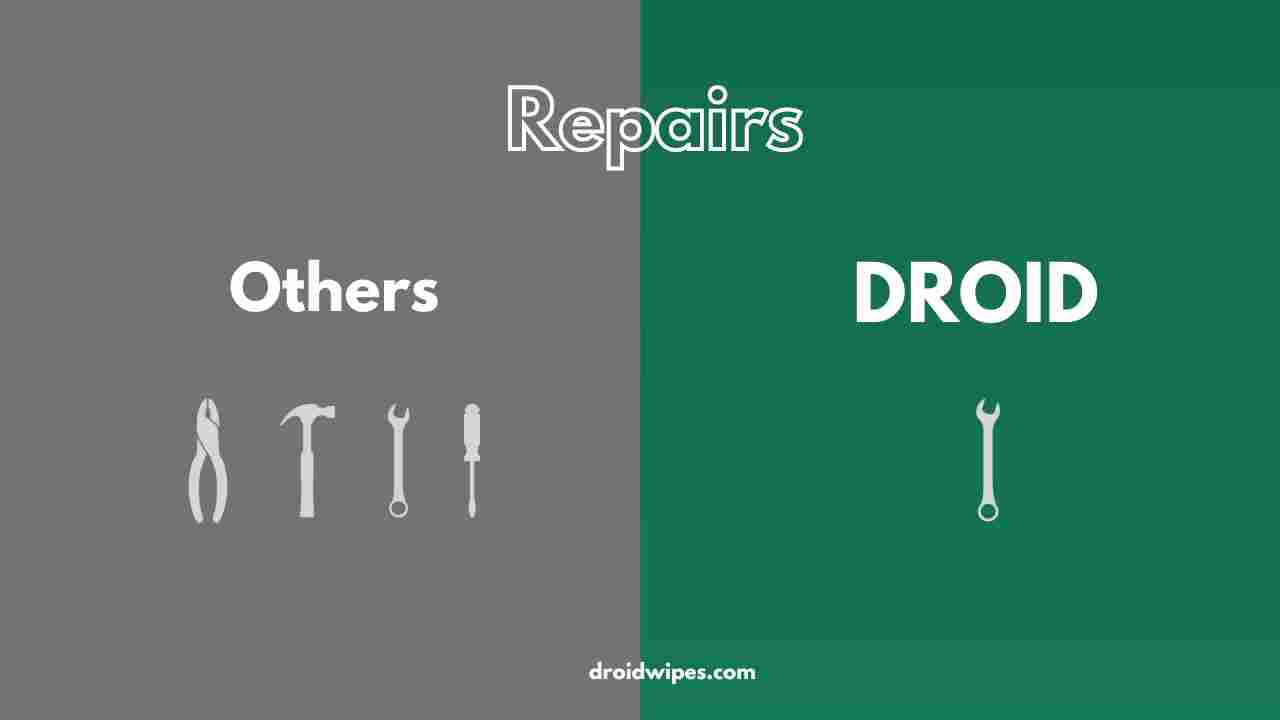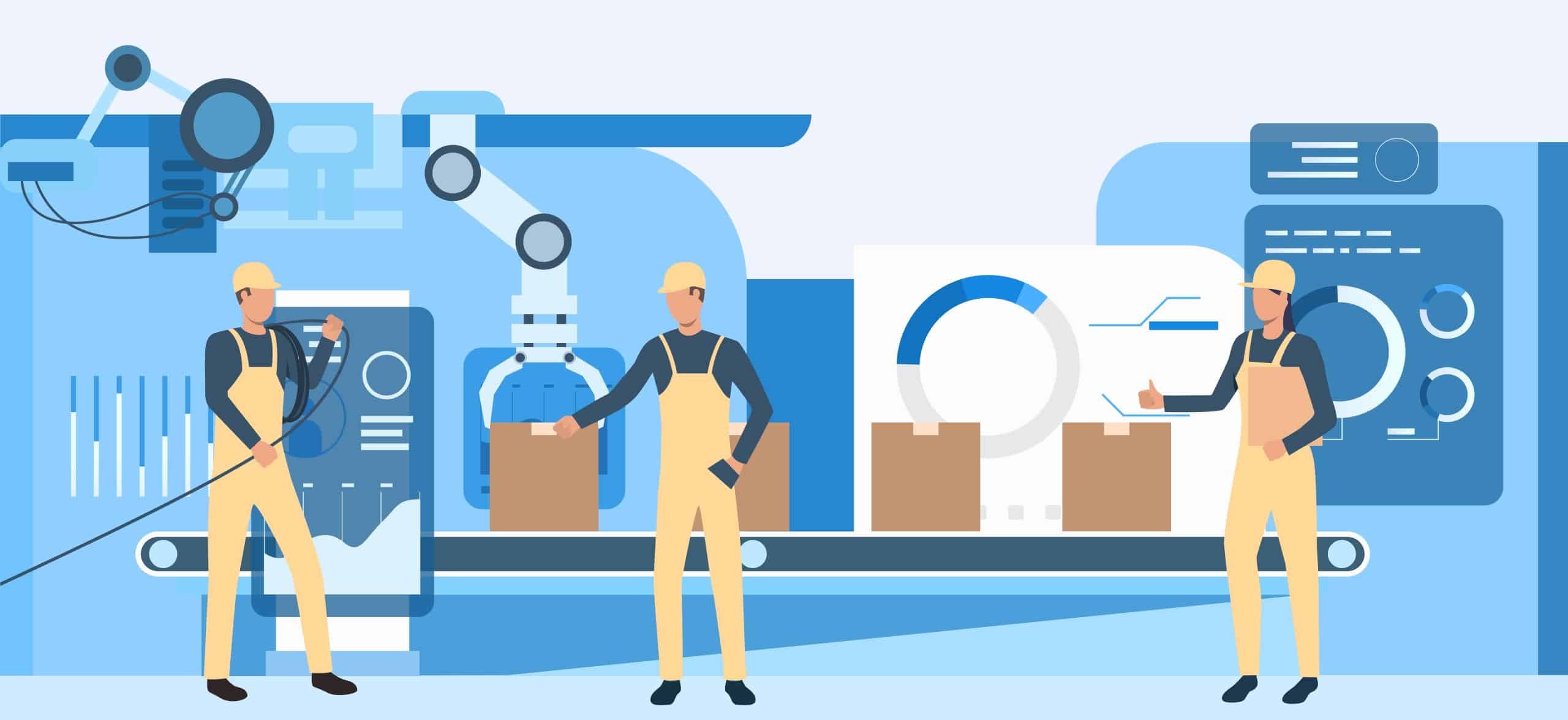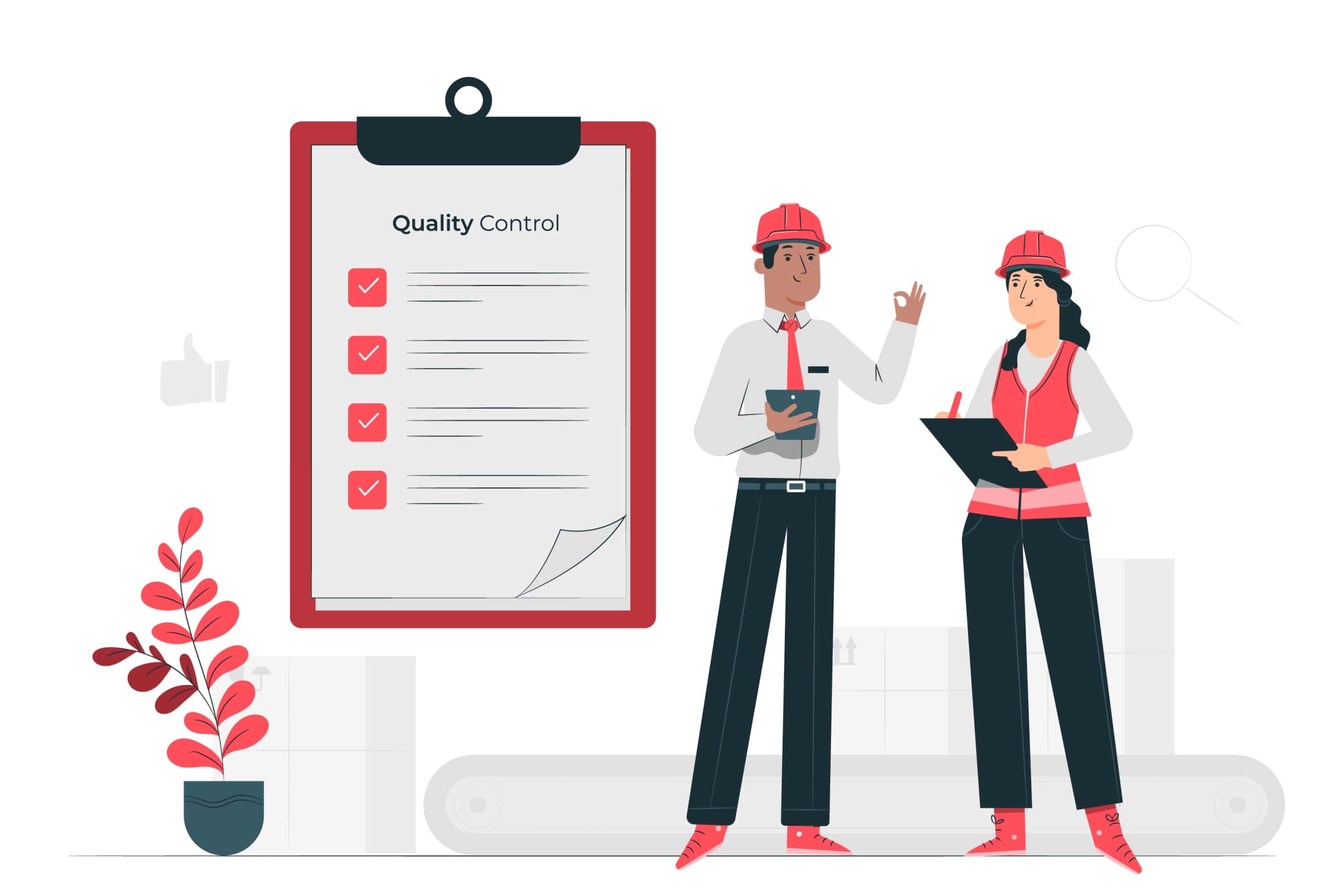1. Regular Cleaning and Inspection
Regular maintenance and examination of wet wipes machines are essential procedures that have a significant effect on the durability and effectiveness of the equipment. The wet wipes manufacturers frequently result in the production of dust, debris, and residue from the product. These substances might build up on different parts of the machine. Without proper intervention, these pollutants can result in obstructions, heightened deterioration of mobile components, and ultimately result in machine faults or failures. Hence, it is imperative to adopt a regular cleaning regimen to uphold the highest level of machine efficiency.
The cleaning process should be conducted with great attention to detail, specifically targeting critical components such as the cutting and folding mechanisms, rollers, and dispensing nozzles. To prevent any harm to the fragile components of the machine, it is crucial to utilize suitable cleaning solutions and techniques as advised by the wet wipes machine manufacturer. It is crucial to not only clean the surfaces that are easily seen but also to thoroughly clean regions that are harder to reach and where dust and debris might build up. This comprehensive method aids in preventing the accumulation of substances that may impede the seamless functioning of the machine.
Regular cleaning is necessary, but frequent inspections are also crucial to detect early indications of wear, damage, or possible problems. Inspections should be carried out methodically, adhering to a comprehensive checklist that encompasses all essential elements of the machine. During these checks, observe for indications of deterioration such as frayed belts, blunt blades, or insecure fittings. Tackling these concerns early helps avert minor faults from growing into significant repairs or generating unforeseen periods of inactivity. Inspections also offer a chance to confirm that all components are properly aligned and operating as intended, hence enhancing the efficiency and dependability of the equipment.
By integrating frequent cleaning and inspection into your maintenance regimen, you may greatly prolong the lifespan of your wet wipes machines. Implementing this proactive technique not only decreases the probability of unforeseen malfunctions but also aids in upholding a steady level of product quality and manufacturing efficiency. Over time, dedicating time and effort to these precautionary actions can result in significant savings on expenses related to repairs and replacements, guaranteeing a seamless and ongoing wet wipes manufacturing process.
2. Lubrication of Moving Parts
Lubrication of moving parts is a vital maintenance technique for guaranteeing the smooth and effective functioning of wet wipes machines. Moving items such as bearings, gears, rollers, and blades undergo continual friction during the production process. This friction, if not effectively handled, can lead to increased wear and tear, overheating, and eventual mechanical failure. Regular and suitable lubrication helps to minimize these concerns, hence extending the lifespan of the wet wipes machine.
Using the correct type of lubricant is vital. Wet wipes manufacturers often prescribe certain lubricants that are most suited for their machinery. These lubricants are designed to resist the operational conditions of the machinery, offering optimal protection against friction and wear. It is vital to avoid using generic or inappropriate lubricants, as they may not provide adequate protection and could potentially cause harm to the machine components.
A constant lubrication schedule is vital for preserving the efficiency of the lubrication. Depending on the frequency and intensity of machine use, lubrication may be required daily, weekly, or monthly. Operators should stick to the wet wipes machine manufacturer’s specifications and lubrication intervals to ensure that all moving parts stay suitably protected. Avoiding excessive lubrication is also important, as it can attract particles and dirt, resulting in blockages and additional damage.
It is important to designate and make easily reachable the areas where lubrication is needed. Operators ought to undergo training to identify these critical spots and comprehend the appropriate quantity of lubricant to provide. Each lubrication point may have distinct specifications, and applying the appropriate quantity guarantees that the lubricant establishes a shielding layer without inducing excessive accumulation. Periodic inspections should be conducted to verify the proper distribution of lubricant to essential components and to identify any obstructions in the lubrication system.
Another crucial part of this maintenance technique is monitoring the lubricant’s condition. Over a while, lubricants can accumulate contaminants such as dust, grit, and debris, which can diminish their efficiency. Regularly monitoring and replenishing the lubricant as necessary guarantees its cleanliness and efficacy. This method also aids in the early detection of possible concerns, such as leaks or contamination, which may suggest underlying mechanical problems.
Ultimately, ensuring that the moving components of wet wipes machines are adequately lubricated is crucial for their optimal and enduring performance. Operators can mitigate the risk of mechanical failure and prolong the lifespan of their equipment by employing appropriate lubricants, adhering to a consistent lubrication schedule, and ensuring sufficient protection for all moving components. Implementing this proactive maintenance strategy not only improves the machine’s efficiency but also ensures a more stable and dependable production workflow.
3. Calibration and Alignment Checks
Calibration and alignment checks are crucial maintenance procedures that guarantee the accuracy, effectiveness, and durability of wet wipes machines. These operations contribute to the preservation of the equipment’s best performance, hence preventing problems that may result in reduced production efficiency, product flaws, and heightened wear on machine components.
Significance of Calibration
Calibration entails the fine-tuning of the wet wipes machine’s settings to guarantee its operation falls within the predetermined parameters. Over time, the wet wipes machine may deviate from its initial settings due to variables such as frequent usage, vibrations, and wear. These inconsistencies can lead to variations in product dimensions, cutting, folding, and dispensing, ultimately impacting the overall quality of the final product. Regular calibration is essential for restoring the wet wipes machine to its optimal performance levels, hence guaranteeing constant product quality.
Calibration must be conducted as a regular component of a scheduled maintenance plan. The calibration frequency is determined by the wet wipes machine’s usage intensity and the wet wipes machine manufacturer’s recommendations. During the calibration process, it is important to verify and modify any pertinent parameters, such as the depth of cutting, alignment of folding, and volume of dispensing, as needed. Accurate calibration requires the use of precise measuring equipment and strict adherence to the manufacturer’s specifications.
Significance of Alignment Inspections
Alignment tests are of similar significance as they guarantee that all components of the wet wipes machine are accurately positioned and functioning in synchronization. Misalignment can result in irregular wearing of parts, heightened friction, and potential mechanical breakdown. For example, if the cutting blades are not properly aligned, they can result in uneven cuts, which can contribute to wastage and inefficiencies. Likewise, rollers that are not properly aligned can cause wet wipes to be folded or dispensed incorrectly.
Regular alignment inspections aid in detecting and rectifying any deviations from the ideal placement of machine components. These inspections should be comprehensive, encompassing all essential components such as blades, rollers, and conveyors. Particular emphasis should be given to places that require precise alignment, such as the cutting and folding operations.
Procedures for Optimal Calibration and Alignment
- Establish a Systematic Timetable: Implement a regular program for calibrating and aligning the machine, taking into account its operational intensity and following the wet wipes machine manufacturer’s guidelines. Consistency is crucial for sustaining peak performance.
- Utilize Precision Tools: Utilize highly accurate measuring tools and instruments to guarantee precise calibration and alignment. Utilizing precision instruments like micrometers, calipers, and alignment gauges can greatly enhance accuracy to a significant degree.
- Follow Manufacturer Guidelines: Comply with the wet wipes machine manufacturer’s guidelines and instructions for calibration and alignment. These recommendations are designed to guarantee that the machine functions within its intended parameters.
- Document Adjustments: Record all calibration and alignment actions, including any corrections performed, in a thorough manner. These recordings can be utilized to monitor the machine’s performance over some time and discover any reoccurring faults.
- Train Operators: Train operators to be proficient in calibration and alignment processes. Competent operators can execute these activities with precision and effectiveness, minimizing the likelihood of mistakes.
- Monitor Performance: Following the process of calibration and alignment, observe the wet wipes machine’s performance to confirm the effectiveness of the changes. Seek enhancements in the quality and uniformity of the product, as well as any decrease in mechanical problems.
To optimize the performance and extend the lifespan of your wet wipes machines, it is crucial to include frequent calibration and alignment checks as part of your maintenance program. These techniques contribute to the preservation of the accuracy and effectiveness of the equipment, guaranteeing the creation of high-quality goods and reducing the amount of time the equipment is not in operation. Investing in accurate calibration and alignment decreases maintenance expenses and enhances the wet wipes manufacturing process’s dependability and efficiency.
4. Replace Worn Parts Promptly
Timely replacement of damaged components is a crucial factor in ensuring the effectiveness and durability of wet wipes machines. Over a while, many components such as blades, belts, rollers, and gears experience deterioration and damage as a result of the continuous mechanical strain they face throughout production. Failure to promptly repair these components can result in substantial operational problems, such as reduced efficiency, compromised product integrity, and unforeseen equipment failures.
The Significance of Prompt Replacement
Defective components can lead to a range of issues during the wet wipes manufacturing process. For instance, blades that lack sharpness may fail to properly slice through the wipes, resulting in ragged edges and a higher amount of discarded material. Likewise, if the rollers are worn out, they may not effectively guide the material, leading to wet wipes that are not aligned or folded appropriately. These concerns not only impact the overall quality of the end product but also raise the probability of manufacturing errors and the need for rework, which can result in significant costs and time delays.
Replacing worn parts promptly is essential for ensuring the machine operates at its peak capability. By proactively managing wear and tear, you can avoid minor concerns from progressing into significant harm. This proactive strategy guarantees the continuous smooth and efficient operation of the machine, reducing the amount of time it is not functioning and ensuring a consistent level of production output.
Determining the Presence of Worn Components
Periodic inspections are crucial for detecting worn components. Operators should get training to identify indications of deterioration, such as atypical sounds, vibrations, reduced efficiency, or observable harm to parts. Incorporating a proactive maintenance schedule that encompasses regular inspections of vital components can facilitate the early identification of deterioration.
Aside from conducting visual examinations, tracking performance indicators can offer useful insights into the state of machine components. For example, if there is a rise in the number of goods being rejected or a decrease in the speed of production, it may suggest that specific components are deteriorating and require replacement. Maintaining comprehensive records of these parameters can aid in forecasting the need for part replacement, enabling prompt action.
Managing an Inventory of Replacement Components
It is imperative to maintain an inventory of vital spare parts to ensure rapid replacement. By ensuring an ample supply of frequently used components, such as blades, belts, and rollers, the likelihood of extended periods of inactivity due to the need to order and receive parts is minimized. Obtaining replacement components of superior quality from trustworthy vendors is crucial to guarantee compatibility and long-lasting durability.
Implementing a methodical arrangement of the spare parts inventory, along with well-defined storage labels and frequent audits, helps optimize the process of replacing parts. This guarantees that the essential components are consistently accessible and readily identifiable when required, hence enabling prompt and effective maintenance.
Advantages of Timely Replacement
Replacing worn parts immediately offers advantages that go beyond simply sustaining wet wipes machine operation. Consistently replacing components improves overall production efficiency by ensuring the machine functions at its planned capacity without any disruptions caused by part failures. This not only enhances efficiency but also enhances product quality and uniformity.
Furthermore, taking proactive measures to address wear and tear might prolong the overall lifespan of the wet wipes machine. By mitigating the excessive strain on other components resulting from failing parts, you decrease the likelihood of more extensive damage that may require expensive repairs or complete replacement of the machine. Over time, making timely investments in replacing parts can result in substantial cost savings by reducing repair costs and preventing unexpected production interruptions.
Ultimately, the timely replacement of damaged components is a crucial technique for preserving the well-being and effectiveness of wet wipes machines. By conducting frequent inspections, keeping a supply of spare parts, and implementing proactive maintenance measures, you can guarantee that your equipment stays in its best possible shape. This strategy enhances both productivity and product quality while also safeguarding your investment by extending the machine’s lifespan and guaranteeing a seamless and uninterrupted wet wipes manufacturing process.
5. Operator Training
Training operators is essential for ensuring the optimal performance, safety, and durability of wet wipes machines. Proficient operators who have received thorough training can have a substantial influence on the overall efficiency of the equipment, guaranteeing seamless operations, reducing the amount of time that the equipment is out of service, and averting expensive errors. Investing in comprehensive training programs not only improves the skills of the personnel but also leads to a more efficient and secure production environment.
The Significance of Thorough Training
Operators are the primary users of wet wipes machines, tasked with their daily operation and doing minor maintenance duties. In the absence of adequate training, operators may unintentionally mishandle the equipment, resulting in heightened deterioration, frequent malfunctions, and uneven product quality. Thorough training provides operators with the essential knowledge and abilities to efficiently operate the machines, identify early indications of possible problems, and accurately carry out routine maintenance activities.
Key Areas of Operator Training:
- Comprehending Machine Functions: Operators must possess a comprehensive comprehension of the wet wipes machine’s operations, encompassing the knowledge of initiating, halting, and modifying the equipment. They ought to possess knowledge of the machine’s control panel, settings, and the distinct functionalities of each component. This knowledge aids in maximizing the machine’s efficiency and guarantees its proper utilization.
- Routine Maintenance and Troubleshooting: Training should encompass normal maintenance chores, including cleaning, lubrication, and small adjustments. Operators must be proficient in executing these activities according to the wet wipes machine manufacturer’s instructions. In addition, it is important to provide training for individuals to recognize and resolve typical problems, such as misalignments, obstructions, or abnormal sounds. Timely identification and settlement of difficulties help avert the transformation of minor problems into significant interruptions.
- Safety Procedures: The utmost importance is placed on ensuring the safety of operators. Training should encompass comprehensive safety precautions, including meticulous instructions on the correct use of tools and materials, the secure operation of machinery, and the processes for emergency shutdown. Operators should get training on the proper utilization of personal protection equipment (PPE) and the need to uphold a hygienic and orderly work environment to avert mishaps.
- Quality Control: Operators are essential for ensuring product quality. The training should prioritize the significance of adhering to quality standards and specifications. Operators should possess the capability to examine the result for any flaws and comprehend the necessary measures to rectify quality problems. Emphasizing quality control contributes to the production of wet wipes that are consistently high in quality.
- Record Keeping and Documentation: Effective record-keeping and documentation are crucial for monitoring the wet wipes machine performance and maintenance operations with precision. Operators ought to receive training on how to record their observations, document the maintenance activities they have carried out, and report any difficulties they come across. This information is crucial for maintenance planning, diagnosing problems, and enhancing the general efficiency of the unit.
Advantages of Regular Training Updates
Consistent upgrades to operator training programs are crucial to stay up-to-date with technology breakthroughs and changes in production processes. Operators must continuously update their knowledge and skills to keep up with the newest advancements in machinery, software, and processes. Continual training guarantees that operators maintain their expertise and can utilize emerging technology to improve productivity and efficiency.
Furthermore, consistent training sessions can strengthen optimal methods and safety procedures, hence diminishing the likelihood of operator negligence. Refresher courses contribute to the maintenance of safety and operating procedures by ensuring that they remain at the forefront of individuals’ minds, thus promoting a culture of ongoing enhancement and attentiveness.
Allocating Funds Towards the Acquisition of Training Resources.
It is essential to invest in top-notch training materials, such as comprehensive manuals, instructional films, and interactive workshops, to ensure effective operator training. Collaborating with wet wipes machine manufacturers to offer customized training sessions can also yield significant advantages. Operators should have convenient access to these resources, enabling them to consult training materials whenever necessary.
Implementing formal training programs is important, but it is also beneficial to cultivate a culture of mentorship and peer learning to further improve operator abilities. Experienced operators can impart their experience and skills to newer staff members, so fostering a collaborative learning environment is advantageous to all those involved.
Investing in operator training is crucial as it yields benefits such as higher wet wipes machine performance, decreased downtime, and improved product quality. To ensure a more efficient and safe wet wipes manufacturing process, wet wipes manufacturers can equip operators with the necessary knowledge and abilities to efficiently operate, maintain, and repair wet wipes machines. Consistent training updates and availability of high-quality training materials enhance these advantages, hence enhancing the overall effectiveness and long-term viability of the manufacturing business.
6. Monitor Performance Metrics
Monitoring performance indicators is crucial for guaranteeing the efficient functioning and durability of wet wipes machines. Wet wipes manufacturers can obtain significant insights into the efficiency, productivity, and health of their equipment by methodically monitoring key performance indicators (KPIs). By utilizing data analysis, this method allows for preemptive maintenance, prompt interventions, and ongoing enhancement, resulting in improved production quality and decreased downtime.
Significance of Performance Metrics
Performance metrics offer a measurable assessment of the machine’s operational efficiency. They assist in identifying patterns, detecting deviations, and emphasizing areas that necessitate focus. Consistently monitoring these parameters enables producers to uphold a superior level of operation and promptly resolve any new concerns. By taking a proactive approach, the likelihood of unforeseen malfunctions and expensive repairs is minimized.
Important Performance Metrics to Track
- Production Speed and Result: Monitoring the number of wet wipes manufactured every hour or shift offers a precise measure of the wet wipes machine’s efficiency. A persistent decrease in output speed can indicate underlying problems such as deterioration, misalignment, or inadequate maintenance.
- Downtime and Availability: Downtime and availability can be assessed by quantifying the duration during which the wet wipes machine is functioning properly compared to the time it is out of service for maintenance or repairs. This analysis aids in evaluating the machine’s dependability. Significant periods of inactivity can be indicative of frequent equipment failures or ineffective maintenance methods, which may require a thorough examination of maintenance schedules and processes.
- Defect Rates: Monitoring the frequency of faulty goods aids in evaluating the machine’s efficiency and the standard of the output. An escalation in defects may indicate issues such as blunt blades, misplaced components, or inaccurate machine configurations. Promptly identifying and resolving these issues guarantees a constant level of product quality.
- Energy Consumption: Monitoring energy usage can offer valuable insights into the machine’s efficiency. If energy consumption rises without a proportional increase in production, it suggests the presence of mechanical problems or inefficiencies that require attention. Efficient energy utilization not only decreases operational expenses but also promotes ecological initiatives.
- Material Waste: Measuring the quantity of material that is discarded during production enables the identification of inefficiencies in the process. Inadequate wet wipes machine configurations, deteriorated components, or mistakes made by operators can lead to significant amounts of waste. Minimizing trash enhances cost-effectiveness and promotes environmental sustainability.
- Maintenance Records: Maintaining comprehensive documentation of all maintenance operations, encompassing regular inspections, component substitutions, and repairs, offers a historical perspective on the wet wipes machine’s functionality and condition. Examining these records can aid in forecasting future maintenance requirements and strategizing preventative steps.
Advantages of Monitoring Performance Metrics
Monitoring performance measurements has numerous advantages, such as:
- Proactive Maintenance: Implementing proactive maintenance involves consistently monitoring key performance indicators (KPIs) to detect and address possible issues before they escalate into significant problems. By adopting a proactive strategy, maintenance can be carried out promptly, hence minimizing the chances of unforeseen problems.
- Enhanced Productivity: Through the examination of performance data, producers can pinpoint areas of congestion and ineffectiveness within the production process. Implementing specific enhancements based on these observations improves overall efficiency and productivity.
- Improved Product Quality: By closely monitoring defect rates and other quality-related data, any departures from quality requirements may be promptly remedied. Emphasizing quality control ensures the maintenance of a superior level of output.
- Cost Savings: Implementing efficient monitoring and maintenance techniques decreases the frequency of repairs and part replacements, resulting in substantial cost savings. In addition, the optimization of energy use and the reduction of material waste help to decrease operational costs.
- Data-Driven Decision Making: This involves using performance data to make educated judgments on machine operation, maintenance schedules, and process enhancements. These measurements give a factual basis for decision making. The utilization of data in this technique facilitates ongoing enhancement and strategic decision-making.
Implementing Performance Monitoring
In order to efficiently track performance indicators, wet wipes manufacturers should:
- Implement Monitoring Systems: Employ sensors and automated monitoring systems to gather up-to-the-minute data on crucial performance indicators. These systems can offer uninterrupted feedback and notify operators of any deviations from standard parameters.
- Establish Benchmarks: Set performance benchmarks by referring to the wet wipes machine manufacturer’s specifications and historical data. By comparing the existing performance with these standards, one can find areas that need improvement.
- Regular Reporting: Generate periodic reports that provide a summary of the machine’s performance indicators. Maintenance teams and management must evaluate these reports to monitor progress and strategize maintenance actions.
- Train Operators: Train operators to possess the knowledge and skills necessary to comprehend and analyze performance measures. They should possess the ability to identify early indications of prospective problems and implement suitable measures to resolve them.
- Continuous Improvement: Utilize performance data to propel ongoing enhancement endeavors. Consistently evaluate and revise maintenance processes, machine settings, and operational procedures using information obtained from performance measurements.
Ultimately, the process of monitoring performance indicators is essential for ensuring the efficiency, dependability, and durability of wet wipes machines. Wet wipes manufacturers can achieve optimal machine functioning, enhance product quality, and decrease operational costs by methodically monitoring and evaluating key performance indicators. Utilizing data to drive decision-making enables preventive maintenance and ongoing enhancements, hence promoting the overall success and long-term viability of the wet wipes manufacturing process.
7. Implement a Preventive Maintenance Schedule
Implementing a preventative maintenance schedule is a preemptive strategy to guarantee the effective and dependable functioning of wet wipes machines. Preventive maintenance, in contrast to reactive maintenance, is the implementation of scheduled inspections, servicing, and part replacements to proactively avoid problems before they happen. This method not only prolongs the lifespan of the equipment but also improves production, minimizes downtime, and preserves product quality.
Advantages of Proactive Maintenance
Preventive maintenance provides a multitude of benefits compared to reactive maintenance. Through frequent maintenance, wet wipes manufacturers may proactively detect and address any problems in the wet wipes machines, thus preventing unforeseen malfunctions and expensive repairs. By adopting this proactive strategy, the occurrence of production disruptions is minimized, resulting in a wet wipes manufacturing process that is more consistent and reliable. In addition, ensuring that equipment is kept in optimal condition is beneficial for creating high-quality products and minimizing the chances of faults and rework.
Essential Components of a Preventive Maintenance Program
- Timetable Regular Inspections: Regular inspections are essential for doing preventive maintenance. The inspections should be thorough, encompassing all essential elements of the wet wipes machines, including blades, rollers, belts, and motors. Operators should rapidly inspect for indications of wear, damage, or misalignment and promptly resolve these concerns.
- Scheduled Servicing: Preventive maintenance should incorporate routine servicing according to the manufacturer’s guidelines and the wet wipes machine’s level of usage. This may entail the processes of cleansing, lubricating, calibrating, and replacing components. Adhering to a methodical maintenance schedule aids in preserving the machine’s efficiency and averting degradation.
- Component Replacements: Certain components of the machine, such as blades and belts, have a finite lifespan and require frequent replacement. The preventive maintenance schedule should indicate the specific time intervals for replacing these components, regardless of whether or not they exhibit any obvious indications of wear. This proactive strategy guarantees the seamless operation of the wet wipes machine by preventing any unforeseen malfunctions.
- Documentation: Thorough documentation of all maintenance actions is crucial for monitoring the machine’s condition and efficiency over a period of time. The records should encompass details regarding inspections, maintenance, component replacements, and any detected problems. Ensuring precise documentation aids in strategizing future maintenance and pinpointing persistent issues that may demand further focus.
- Performance Monitoring: By integrating performance monitoring with preventative maintenance, one can gain useful insights into the machine’s state. Operators can analyze crucial performance indicators, including production speed, defect rates, and downtime, to detect patterns and make necessary adjustments to the maintenance schedule to resolve emergent problems.
Creating a Proactive Maintenance Strategy
In order to create a successful preventive maintenance strategy, wet wipes manufacturers should begin by referring to the wet wipes machine’s user manual and following the advice provided by the wet wipes machine manufacturer. These documents usually offer instructions for the frequency and methods for maintaining the equipment. Using this data, it is possible to generate a personalized maintenance plan that is designed to meet the unique requirements and usage patterns of the manufacturing facility.
- Assess Machine Usage: Conduct a machine usage assessment to analyze the level and frequency of machine utilization to establish suitable intervals for maintenance. Wet wipes machines that are used often may necessitate more frequent maintenance than ones that are utilized less intensely.
- Create a Maintenance Checklist: Generate a comprehensive maintenance checklist that encompasses all maintenance duties, such as examinations, sanitation, lubrication, calibration, and component substitutions. The checklist should indicate the frequency of each task and the individuals who are responsible for completing them.
- Allocate Duties: Precisely establish the specific tasks and obligations of the maintenance personnel and machine operators. Ensure that all individuals engaged comprehend their assigned responsibilities and the significance of strictly following the maintenance timetable.
- Execute and Supervise: After establishing the preventive maintenance plan, ensure its continuous implementation. Assess the efficacy of the plan by monitoring maintenance operations and machine performance. Modify the timetable as necessary according to feedback and performance statistics.
- Continuous Improvement: Consistently assess and revise the preventive maintenance plan to integrate fresh perspectives, technical progress, and modifications in manufacturing procedures. Continuous improvement guarantees that the maintenance program stays pertinent and efficient.
Implementing a preventative maintenance program is a methodical technique to ensure the well-being and effectiveness of wet wipes machines. Wet wipes manufacturers can prevent unforeseen malfunctions, minimize periods of inactivity and improve the quality of their products by conducting routine inspections, maintenance, and replacing components as needed. Implementing this proactive maintenance technique not only increases the longevity of the equipment but also enhances the dependability and efficiency of the wet wipes manufacturing process. Implementing preventative maintenance strategies results in financial savings, enhanced operational effectiveness, and increased customer contentment.
8. Keep Detailed Maintenance Records
Keeping comprehensive records of all maintenance actions is a crucial practice to guarantee the efficient operation and long lifespan of wet wipes machines. These data offer a thorough chronicle of the wet wipes machine’s state, maintenance, and repairs, providing significant insights that can aid in proactive maintenance planning, troubleshooting, and general equipment management.
Significance of Comprehensive Maintenance Records
- Monitoring Machine Performance: Comprehensive maintenance records provide the monitoring and assessment of the efficiency and condition of wet wipes machines throughout their lifespan. Operators can track trends and detect patterns in wet wipes machine behavior by thoroughly documenting each inspection, repair, and part replacement. Acquiring this historical data is essential for identifying repetitive problems, comprehending the reasons behind failures, and making well-informed choices on future maintenance requirements.
- Enabling Proactive Maintenance: By maintaining detailed maintenance records, operators may predict when certain components are likely to require replacement or when the wet wipes machine will need to be serviced. This proactive strategy enables prompt intervention, thereby averting unforeseen malfunctions and reducing operational downtime. By utilizing previous data, maintenance procedures may be scheduled to guarantee that the equipment remains in its best functioning condition, hence minimizing the possibility of production interruptions.
- Enhancing Troubleshooting and Repairs: Comprehensive maintenance records can greatly assist in identifying and resolving issues when a wet wipes machine experiences a problem. Technicians can expediently uncover probable causes and solutions by scrutinizing previous maintenance actions and concerns. This method increases efficiency and accuracy in repairs by saving time and minimizing trial-and-error procedures.
- Enforcing Compliance and Responsibility: In businesses subject to regulations, it is frequently necessary to keep precise maintenance records to meet compliance standards. These documents exhibit compliance with industry norms and regulations, serving as proof of appropriate equipment maintenance. In addition, comprehensive records help to establish responsibility for maintenance workers, ensuring that all scheduled tasks are carried out and recorded as necessary.
Essential Components of Maintenance Records
In order to be efficient, maintenance records should encompass the subsequent crucial components:
- Date and Time: Record the date and time of each maintenance action to generate a precise chronology of occurrences. This aids in monitoring the frequency of maintenance chores and discerning patterns in equipment performance.
- Activity Description: Furnish a comprehensive account of each maintenance task, encompassing examinations, sanitation, lubrication, component substitutions, and repairs. Please provide a detailed description of the components and the specific tasks completed.
- Personnel Involved: Document the identities of the individuals who carried out the maintenance duties. This information is crucial for ensuring responsibility and for pinpointing any deficiencies in training or gaps in skills within the maintenance staff.
- Observations and Findings: Record any notable observations or findings that were made during inspections and servicing. This may encompass indications of deterioration, atypical sounds, seepage, or other complications. Precise observations are beneficial for identifying issues and strategizing for future maintenance.
- Replaced Parts: Enumerate all replaced components, specifying the part numbers and vendors. Maintaining a record of replacement parts facilitates inventory management and guarantees the utilization of top-notch, compatible components.
- Upcoming Maintenance: Provide information about the next scheduled maintenance event depending on the current servicing. This guarantees consistent adherence to the maintenance schedule and aids in the strategic planning and allocation of resources.
Optimal Methods for Preserving Documents
- Utilize a Digital System: Deploy a computerized maintenance management system (CMMS) to optimize the process of recording and managing maintenance activities. Digital systems provide convenient access to past data, automated scheduling, and the capability to generate reports and analytics.
- Standardize Documentation: Create uniform forms and templates to document maintenance tasks. Adhering to consistent documentation procedures guarantees the precise and thorough recording of all essential information.
- Train personnel: Ensure that all maintenance staff and machine operators receive comprehensive training in the correct procedures for documenting their work. Highlight the significance of precise and comprehensive record-keeping as an integral component of the overall maintenance strategy.
- Regular Audits: Perform routine audits to validate the accuracy and comprehensiveness of maintenance data. Audits facilitate the detection of any deficiencies in documentation and verify that the records are current.
- Integrate with Performance Metrics: Integrate maintenance records with performance measurements to enhance understanding of machine performance and the effectiveness of maintenance activities. This comprehensive strategy facilitates decision-making based on data and promotes ongoing enhancement.
Maintaining meticulous maintenance records is a crucial practice for efficiently managing wet wipes machines. These data offer a historical chronicle of all maintenance activities, enabling preventive maintenance, streamlined troubleshooting, and adherence to industry standards. Wet wipes manufacturers can guarantee the accuracy, comprehensiveness, and easy accessibility of their maintenance data by adopting optimal record-keeping methods and utilizing digital technologies. Consequently, this serves the primary objective of upholding optimal equipment dependability, minimizing operational interruptions, and improving production effectiveness.
9. Use High-Quality Consumables
Utilizing premium consumables in the production of wet wipes is crucial for upholding the efficiency, dependability, and excellence of the manufacturing process. Consumables encompass many materials, including as wipes, substrates, cleaning solutions, lubricants, and replacement parts. The selection of these materials has a direct influence on the performance of the machine, the quality of the product, and the overall costs of production. Purchasing premium consumables can result in substantial long-term advantages, guaranteeing seamless operations and reducing maintenance problems.
The Influence of Consumables on Machine Performance
- Consistency and Dependability: Premium consumables are produced with meticulous standards, guaranteeing uniformity in their characteristics and functionality. Employing such materials minimizes the likelihood of fluctuations in the wet wipes manufacturing process, resulting in enhanced machine performance and uniform product excellence. Substandard consumables may exhibit inconsistent characteristics, leading to frequent modifications and interruptions in the production process.
- Minimized Degradation: Essential maintenance of wet wipes machines involves the utilization of consumables such as lubricants and cleaning solutions to prevent excessive wear and tear. Premium lubricants minimize friction and abrasion on mobile components, prolonging their durability and averting premature malfunctions. Likewise, efficient cleaning solutions guarantee the complete elimination of residues and pollutants, so maintaining the equipment in its best possible state and minimizing the necessity for frequent maintenance.
- Maximizing Performance: Utilizing top-notch replacement components, such as blades, rollers, and belts, guarantees optimal functioning of the machine. These components are specifically engineered to meet or beyond the criteria set by the original equipment manufacturer, ensuring a perfect and superior fit as well as optimal performance. Utilizing inferior components might result in misalignments, heightened deterioration, and frequent malfunctions, so adversely affecting manufacturing efficiency.
Advantages of Utilizing Premium Consumables
- Improved Product Quality: The caliber of consumables has a direct impact on the end product. For instance, the usage of superior wipes substrates guarantees that the wipes have qualities such as softness, durability, and effectiveness in their designated purpose. Maintaining a consistently high level of product quality not only increases customer pleasure but also contributes to the establishment of a strong brand reputation.
- Minimized Downtime and Maintenance Expenses: Utilizing superior consumables decreases the occurrence of machine problems and breakdowns. Consequently, this results in decreased periods of inactivity and decreased expenses for upkeep, as there is a diminished requirement for repairs and component substitutions. By allocating resources to high-quality materials, one can effectively reduce expenses over time by reducing disruptions in production and prolonging the durability of the equipment.
- Enhanced Efficiency: The utilization of dependable consumables enhances the overall efficiency of the production process. Mechanical systems function seamlessly with reduced disruptions, enabling enhanced production velocities and optimal resource usage. This improved efficiency results in enhanced productivity and profitability.
- Adherence to Standards: Superior consumables frequently satisfy or beyond industry standards and regulations. This is especially crucial in industries where cleanliness and safety are of utmost importance, such as healthcare and consumer goods. Employing authorized materials guarantees adherence to regulatory mandates and mitigates the likelihood of product recalls or legal complications.
- Optimal Consumable Selection: Opt for esteemed vendors renowned for their exceptional quality and unwavering dependability. Conduct thorough research on their certifications, customer reviews, and industry reputation to verify that they fulfill your criteria. Cultivating a robust partnership with dependable suppliers helps provide a steadfast commitment to unwavering quality and punctual deliveries.
- Material Specifications: Verify that the consumables adhere to the precise specifications of your production process. Examine the technical parameters and assess the compatibility of the materials with your equipment. Utilizing materials that are specifically engineered for your machinery guarantees peak performance and minimizes the likelihood of problems.
- Quality Assurance: Establish a rigorous quality assurance procedure to examine and evaluate consumables before their utilization. Consistently oversee the quality of incoming materials and regularly do audits of suppliers to uphold elevated standards. This proactive strategy aids in the early detection and resolution of quality concerns.
- Cost-Benefit Analysis: Although high-quality consumables may entail a greater initial expense, it is important to take into account the long-term advantages and cost reductions they provide. Assess the overall expenses associated with owning a product, taking into account the benefits of decreased maintenance, minimized production disruptions, and improved product quality. Allocating funds towards high-quality materials has the potential to yield substantial long-term profits.
Utilizing high-quality consumables is crucial for the effective and dependable functioning of wet wipes machines. These materials are essential for preserving machine performance, guaranteeing product quality, and minimizing maintenance expenses. Wet wipes manufacturers can enhance their wet wipes manufacturing processes and attain superior results by selecting reliable suppliers, validating material standards, and establishing robust quality assurance procedures. Investing in premium consumables eventually contributes to the objective of manufacturing superior products, improving customer happiness, and sustaining a competitive advantage in the market.
10. Stay Updated with Technological Advancements
Keeping up-to-date with technical changes is essential for ensuring the competitiveness, efficiency, and productivity of wet wipes manufacturing. The domain of manufacturing technology is in a constant state of evolution, with advancements that augment machine efficiency, simplify production procedures, and promote product excellence. Wet wipes manufacturers can get an advantage over their competitors by staying updated on these breakthroughs and utilizing new technologies to improve operations and minimize expenses.
The Significance of Technological Progress
- Improved Efficiency: Technological progress frequently results in enhanced production processes that are more efficient. Implementing innovations like as automated systems, better sensors, and enhanced machine designs can have a substantial impact on increasing production speeds and minimizing downtime. By adopting these technologies, manufacturers can increase their production efficiency and profitability by reducing resource consumption.
- Enhanced Product Quality: Utilizing new technology can optimize the quality of wet wipes by guaranteeing heightened accuracy and uniformity throughout the wet wipes manufacturing process. The utilization of advanced control systems, high-precision cutting tools, and new materials can all play a significant role in the production of exceptional goods that not only meet but also beyond client expectations.
- Cost Reduction: Technological innovations can result in cost savings across various domains. Automation diminishes the necessity for human work, sophisticated monitoring systems can avert expensive malfunctions, and energy-efficient devices decrease utility expenses. Manufacturers can achieve substantial decreases in operational costs by embracing cutting-edge technologies.
- Sustainability: The significance of advancements in sustainable manufacturing technology is growing steadily. Adopting technologies that decrease energy usage, eliminate waste generation, and utilize environmentally friendly materials enables manufacturers to comply with regulatory standards and attract environmentally concerned consumers. Keeping up to date with these innovations promotes sustainable practices and improves corporate responsibility.
Methods for Staying Up-To-Date
- Attending Industry Conferences and Trade Shows: Participating in industry conferences and trade exhibitions is a highly effective method to acquire knowledge about the most recent technology breakthroughs. These events offer chances to witness the practical use of cutting-edge technologies, participate in educational workshops and seminars, and establish professional connections with industry professionals and colleagues. Exhibitors frequently display the most recent technology, software, and materials, providing direct insights into upcoming trends.
- Professional Associations and Networks: Becoming a member of professional associations and industry networks can offer significant tools for remaining up-to-date on technology advancements. These organizations frequently provide newsletters, papers, webinars, and training sessions that showcase emerging technologies and optimal methods.
- Partnerships with Suppliers: Developing robust partnerships with suppliers enables wet wipes manufacturers to stay updated on the most recent advancements in equipment and materials. Suppliers are typically the primary source of information regarding new technologies and can offer demonstrations, training, and updates on advancements that have the potential to enhance the wet wipes manufacturing process.
- Online Resources: Utilizing online resources, such as industry blogs, forums, and social media, can enable wet wipes manufacturers to stay up-to-date with technical breakthroughs. Various industry professionals and organizations disseminate news, research, and case studies through Internet platforms, offering significant insights into recent advancements.
- Training and Education: Investing in continuous training and education for employees guarantees that the workforce remains well-informed about the most recent advancements in technology. Consistent training sessions, workshops, and courses can provide personnel with the necessary abilities to proficiently operate new equipment and successfully adopt innovative practices.
- Collaborating with Research Institutions: Forming partnerships with research institutions and universities can grant access to state-of-the-art research and groundbreaking ideas. These partnerships can result in the creation and application of novel technologies customized to meet specific production requirements.
Implementing Technological Innovations
- Evaluate Requirements and Advantages: Before using novel technologies, evaluate the precise requirements of your manufacturing process and the potential advantages of the innovations. Take into account how the technology will enhance efficiency, quality, and cost-effectiveness.
- Pilot Testing: Employ new technologies on a limited scale initially to assess their efficacy and detect any possible complications. Pilot testing enables the opportunity to make necessary modifications and enhancements before the whole deployment.
- Integration Strategy: Formulate a comprehensive strategy for seamlessly incorporating novel technology into the current production process. This includes the process of instructing employees, revising protocols, and guaranteeing harmonization with existing systems.
- Monitor and Evaluate: Following deployment, consistently monitor the efficiency of the new technology and assess its influence on the manufacturing process. Collect input from operators and implement any required modifications to optimize advantages.
- Maintain Agility: Given the ever-changing technology world, it is crucial to stay adaptable and receptive to continuous enhancements. Consistently evaluate and revise technical tactics to guarantee that the production process consistently leverages the most recent breakthroughs.
Keeping up-to-date with technical changes is crucial for the ongoing success and competitiveness of wet wipes manufacturing. Wet wieps manufacturers can optimize productivity, boost product quality, minimize expenses, and promote sustainable practices by adopting new technologies. By utilizing resources such as industry events, professional networks, supplier alliances, internet platforms, and training programs, manufacturers may guarantee their position at the forefront of technological innovation. By using these developments in a planned and strategic manner, wet wipes manufacturers can optimize their operations and attain long-term growth and profitability.











